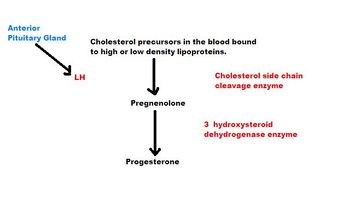Corpus Luteum - Anatomy & Physiology
| This article is still under construction. |
Introduction
Corpus Luteum is latin for "yellow body". The Corpus Luteum is the structure formed during luteinisation of the follicle after ovulation. The corpus luteum is, however, actually only yellow in the cow and in all other domestic species it is red. This colouration of the corpus luteum is due to the pigment, lutein.
Structure
There are two types of luteal cells present within the corpus luteum:
1. Small luteal cells (<20µm)
Small luteal cells are formed from remodelled follicular theca cells. These cells proliferate during luteinisation. Small luteal cells contain many lipid droplets within their cytoplasm, which is an important source of cholesterol esters for progesterone synthesis.
2. Large luteal cells (20-40µm)
Large luteal cells are formed from follicular granulosa cells that have undergone hypertrophy. These large luteal cells are the endocrine cells of the corpus luteum, producing large amounts of the hormone progesterone.
In some species, secretory granules containing oxytocin or relaxin may be found close to the cell membrane. The corpus luteum may contain a small cavity at its centre, a remnant of the follicular antrum, but many do not. Corpora Lutea are well vascularised. This is important for supply of substrates to steriodogenic luteal cells aswell as removal of steriod products.
Function
The Corpus Luteum is an endocrine structure. The luteal cells are steroidogeneic producing hormones of the luteal phase of the oestrus cycle; Progesterone, oxytocin and relaxin. Progesterone prepares and maintains the uterus for implantation of the fertilised ovum. The number of corpora lutea formed are directly related to the number of oocytes released.
The Corpus Luteum
When the dominant antral follicle ovulates, slight localised haemorrhage occurs at the site of ovulation and fills the former cavity. The small amount of bloody tissue can be observed by the naked eye. Loss of fluid from the antral cavity causes the follicle to collapse into many folds. As a result, some granulosal and thecal layers are pushed into the apex of the ruptured follicle. The protrusion of tissue and ruptured blood vessels forms a structure known as the corpus haemorrhagicum. Following this, the theca interna and granulosa cells differentiate into large and small luteal cells.
Luteal cells contain increased quantities of lipid droplets and the pigment 'lutein'. As the blood is resorbed, a solid Corpus Luteum is formed by proliferation of granulosa and theca intera cells as well as blood vessels. This remains on the surface of the ovary.
In the non-pregnant animal, corpora lutea are transient structures. Cyclic corpora lutea undergo proliferation and vascularisation directly after ovulation. The corpora lutea then regress and degenerate into a connective tissue scar, the Corpus Albicans. If the ovum is fertilised, the corpus luteum remains fully developed and active throughout at least part of the pregnancy.
Control of Progesterone Biosynthesis in the Corpus Luteum
In most species, luteinization and progesterone synthesis is regulated principally by luteinising hormone (LH) in the non-fertile cycle. Further conversion to oestradiol is prevented.
